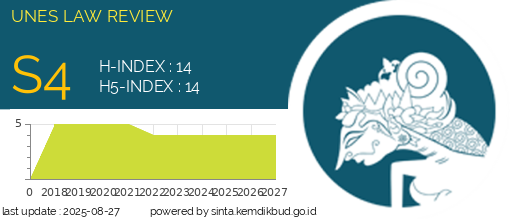THE CONCEPT OF APPLYING LEGAL PROTECTION FOR WITNESSES IN UNCOVERING CORRUPTION CASES BASED ON JUDGE'S DECISION NUMBER 34/PID.SUS-TPK/2020/PN.JKT.PST.
DOI:
https://doi.org/10.31933/unesrev.v5i4.632Keywords:
Witness Victim Protection, Return of Corruption Crime Assets, Judge's Decision, Jiwasraya CaseAbstract
This study aims to analyze the legal efforts undertaken in the context of protecting witness-victims in corruption cases, particularly related to the return of assets of corruption, based on the judge's decision Number 34/Pid.Sus-TPK/2020/PN.Jkt.Pst concerning the Jiwasraya Case. The focus of this research is to identify and analyze the protective measures provided to witness-victims in order to be able to provide information that supports the asset recovery process. The research method used is a normative approach using laws, regulations, and court decisions as a reference. Data was collected through a literature study and analysis of documents related to the Jiwasraya case and the legal framework related to the protection of victim witnesses. The results of the study show that in the judge's decision, there are legal efforts made to protect witness victims in order to return the assets of corruption. These protection efforts include safeguarding the identity of witnesses, providing physical and psychological protection, as well as granting privileges to witness-victims in giving testimony in court. However, several obstacles were found in efforts to protect victim witnesses. Some of them are intimidation or threats against witness-victims, lack of understanding and awareness about witness protection, and difficulties in providing long-term security guarantees for witness-victims. The conclusion of this study is that legal efforts to protect victims-witnesses in corruption cases are very important in returning the assets of corruption. Effective protective measures can increase the confidence of witness-victims to provide accurate testimony and support a fair and transparent asset recovery process.
Downloads
References
Baharuddin Lopa dan Moh. Yamin, 1987, Undang-Undang Tindak Pidana Korupsi (Undang-Undang No. 3 Tahun 1971) Berikut Pembahasan Serta Penerapannya Dalam Praktek, Bandung: Alumni,
Cassella, S. D. 2007, Asset Forfeiture Law in the United States. Chapters 1 and 2. York, NY:Juris Publishing. New,
Deypend Tommy Sibuea, R.B. Sularto, Budhi Wisaksono, 2016, “Kebijakan Hukum Pidana Dalam Perampasan Aset Hasil Tindak Pidana Korupsi Di Indonesia”, Diponegoro Law Review, 5(2),
Ermansjah Djaja. 2010, Meredesain Pengadi/an TindakPidana Korupsi, Implikasi Putusan Mahkamah Konstitusi Nomor 012-016- 019/PUU-IV/2006. Jakarta: Sinar Grafika,
Friedman, Lawrence M. 2011. Sistem Hukum: Perspektif Ilmu Sosial, Diterjemahkan oleh M.Khozim, Ciet. Ke-4. Bandung: Nusa Media,
Hartanti, Evi, 2007, Tindak Pidana Korupsi, Jakarta : Sinar Grafika,
Imelda F.K. Bureni, 2016, “Kekosongan Hukum Perampasan Aset Tanpa Pemidanaan Dalam Undang-Undang Tindak Pidana Korupsi”, Masalah - Masalah Hukum, 45(4),
Marfuatul Latifah, 2015, “Urgensi Pembentukan Undang-Undang Perampasan Aset Hasil Tindak Pidana Di Indonesia”, Jurnal Negara Hukum, 6(1),
Soedjono D, 1997, Pelacuran Ditinjau Dari Segi Hukum Dan Kenyataan Dalam Masyarakat, Bandung, Karya Nusantara:,
Yusuf, M. 2013, Merampas Aset Koruptor; Solusi Pemberantasan Korupsi di Indonesia. Jakarta: Peneribit buku Kompas. Jakarta,
Downloads
Published
How to Cite
Issue
Section
License
Hak cipta :
Penulis yang mempublikasikan manuskripnya di jurnal ini menyetujui ketentuan berikut:
- Hak cipta pada setiap artikel adalah milik penulis.
- Penulis mengakui bahwa UNES Law Review berhak menjadi yang pertama menerbitkan dengan lisensi Creative Commons Attribution 4.0 International (Attribution 4.0 International CC BY 4.0) .
- Penulis dapat mengirimkan artikel secara terpisah, mengatur distribusi non-eksklusif manuskrip yang telah diterbitkan dalam jurnal ini ke versi lain (misalnya, dikirim ke repositori institusi penulis, publikasi ke dalam buku, dll.), dengan mengakui bahwa manuskrip telah diterbitkan pertama kali di Jurnal UNES Law Review.



















